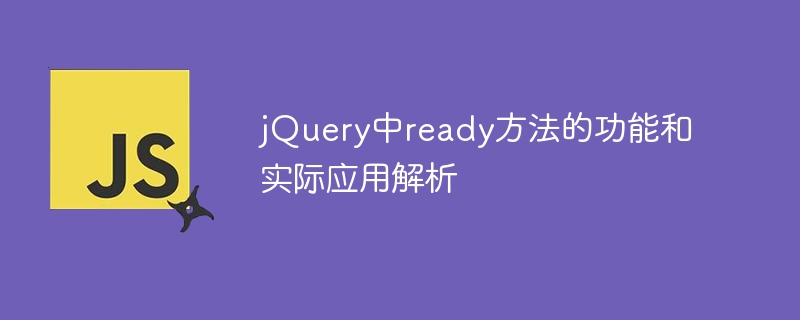Home >Web Front-end >JS Tutorial >Analysis of the functions and practical applications of the ready method in jQuery
Analysis of the functions and practical applications of the ready method in jQuery
- WBOYWBOYWBOYWBOYWBOYWBOYWBOYWBOYWBOYWBOYWBOYWBOYWBOriginal
- 2024-02-28 17:36:04641browse

jQuery is a popular JavaScript library used to simplify DOM manipulation, event handling, animation effects, and more. Among them, the ready method is one of the commonly used methods in jQuery, which is used to execute specific functions after the document is loaded. This article will analyze the functions and practical applications of the ready method in jQuery, and provide specific code examples.
Function Analysis
In traditional JavaScript development, we usually use the window.onload event to execute code that needs to be executed after the page is loaded. However, the window.onload event must wait until all resources in the page (including images, style sheets, etc.) are loaded before it is triggered, which will cause the page to load slower. In contrast, the ready method in jQuery can execute the corresponding code after the DOM structure is loaded, without waiting for all resources to be loaded.
The basic syntax of the ready method is as follows:
$(document).ready(function(){
// 在文档加载完毕后执行的代码
});Another more concise way of writing is:
$(function(){
// 在文档加载完毕后执行的代码
});The function of the ready method is to ensure that the code is executed after the DOM is fully loaded. Therefore, some initialization operations, event binding and other operations are usually performed here.
Actual application analysis
- Page initialization
After the page is loaded, we may need Perform some initialization operations on DOM elements, such as setting default selections, hiding certain elements, etc. This function can be easily achieved using the ready method:
$(function(){
// 设置默认选中项
$("#defaultOption").prop("selected", true);
// 隐藏某些元素
$(".hiddenElement").hide();
});- Event Binding
The ready method is also commonly used to bind events. Make sure the event handler takes effect after the DOM has finished loading. For example, add a click event to the button after the page is loaded:
$(function(){
$("#btnSubmit").click(function(){
alert("按钮被点击了!");
});
});- AJAX request
When using AJAX request to obtain data, usually The code is written in the ready method to make a data request immediately after the page is loaded:
$(function(){
$.get("https://api.example.com/data", function(data){
console.log(data);
});
});- Plug-in initialization
If some jQuery is used Plug-ins usually also initialize the plug-in in the ready method to ensure that the plug-in can be used normally after the page is loaded:
$(function(){
$("#slider").sliderPlugin();
});Through the analysis of the above practical applications, we can see that the ready method in jQuery importance and flexibility. It can help us perform specific operations after the page is loaded, improving user experience and web page performance.
To sum up, the ready method in jQuery is a very practical function, which can ensure that our code is executed after the DOM is loaded, providing a better development experience and performance optimization. By flexibly using the ready method, we can control page behavior more conveniently and provide a better user experience.
The above is an analysis of the functions and practical applications of the ready method in jQuery. I hope it will be helpful to readers.
The above is the detailed content of Analysis of the functions and practical applications of the ready method in jQuery. For more information, please follow other related articles on the PHP Chinese website!

